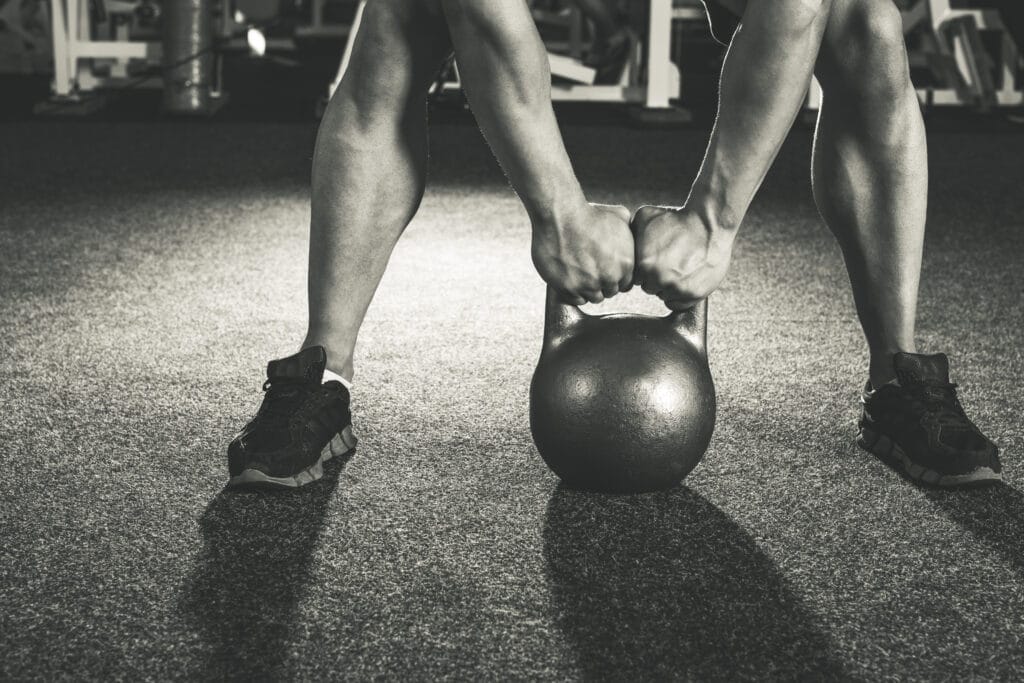
Periodization is an organized approach to exercise that involves varying your workout variables—like intensity, volume, and frequency—over time to optimize performance and prevent plateaus.
It can also be used effectively to help reduce the risk of overtraining, something we should all aim to avoid.
And while periodization is commonly associated with structured gym programs, it can also be effectively applied to home workouts.
In this post, we’ll explore how to use periodization to design effective and sustainable home workout routines that promote continuous progress and long-term success.
After reading, you’ll be ready to start implementing this training schedule to make the most out of your home workouts.
Understanding Periodization
Before diving into the specifics, it’s essential to understand the basic principles of periodization.
Periodization refers to the systematic planning of athletic or training programs in order to achieve peak performance during specific times or seasons.
The primary goal of periodization is to divide a training program into specific phases or periods, each with its own objectives, focus, and intensity levels.
These phases typically progress from general preparation to specific preparation, followed by competition, and finally a transition or recovery phase.
By structuring training in this manner, athletes and individuals alike can optimize their performance, prevent overtraining, and reduce the risk of injury.
Think of a bodybuilder preparing for a competition – they might train really heavy, trying to add mass at one phase and then cut back and do more reps as they get closer to the date of competition.
This changing of volume over time is an example of periodization.
The concept originated in the realm of sports training but has since been adopted in various other fields that involve structured training or development, such as strength and conditioning and even things like academic studies and other skill acquisition.
Phases of Periodization
Periodization typically involves dividing your training program into distinct phases or cycles, each with a specific focus and set of objectives.
Common phases include:
- Base or Foundation Phase: Emphasizes building aerobic endurance, muscular endurance, and fundamental movement patterns.
- Strength Phase: Focuses on increasing muscular strength and power through resistance training exercises.
- Hypertrophy Phase: Targets muscle growth and development through higher volume and moderate intensity workouts.
- Power or Explosive Phase: Prioritizes improving speed, agility, and explosive power through plyometric and high-intensity exercises.
- Peak or Competition Phase: Fine-tunes specific skills, techniques, and performance metrics leading up to a competition or event.
- Recovery or De-load Phase: Incorporates lighter workouts, active recovery techniques, and rest periods to facilitate recovery and prevent overtraining.
The duration of each phase in a periodized training program can vary depending on several factors, including the sport or activity, the athlete’s level of experience, specific goals, competition schedule, and individual needs.
However, most phases usually last somewhere between 4 – 12 weeks.
Training Variables
During each phase, you’ll manipulate specific training variables, including:
- Intensity: Adjusting the load, resistance, or effort level of your exercises.
- Volume: Modifying the number of sets, reps, or total work performed.
- Frequency: Altering the number of training sessions per week or month.
- Exercise Selection: Rotating or varying the exercises, movements, and training modalities (e.g., bodyweight, resistance bands, dumbbells, kettlebells, etc).
One or more of these variables will often be adjusted as you move from one phase to the next.
Linear and Non-Linear Periodization
If we wanna get a little more technical about the concepts of periodization we can think about our workout schedules being linear or non-linear.
I’m not really trying to get too technical, but here’s a quick rundown on the differences between these two strategies:
Linear Periodization
Linear periodization is a more traditional approach that involves progressing through different training phases in a sequential manner, with a gradual increase in intensity and a decrease in volume as athletes move closer to their peak performance phase.
The progression is typically linear, meaning that each phase builds upon the previous one, leading to specific adaptations and improvements over time.
- Sequential Phases: Training is organized into distinct phases (e.g., hypertrophy, strength, power) that follow a specific order.
- Focused Adaptations: Each phase aims to develop specific physical attributes or skills, with a clear progression from general to more sport-specific training.
- Intensity and Volume: Initially, training emphasizes higher volumes with lower intensities during the preparatory phases. As athletes progress, intensity increases, and volume decreases, culminating in the peaking phase.
- Longer Duration: Linear periodization often involves longer phases, with athletes spending extended periods focusing on specific training adaptations before transitioning to the next phase.
Non-linear Periodization
Non-linear periodization, aka “undulating periodization”, involves varying training variables (e.g., intensity, volume, exercises) within shorter time frames, often within the same week or training cycle.
Unlike linear periodization, where phases progress sequentially, non-linear periodization allows for more frequent fluctuations in training variables.
- Varied Training Variables: Within a given week or training cycle, athletes may experience fluctuations in intensity, volume, and exercises. For example, a week might include high-intensity, low-volume sessions followed by low-intensity, high-volume sessions.
- Flexible Structure: Non-linear periodization offers greater flexibility, allowing coaches and athletes to adjust training variables based on individual needs, recovery status, competition schedules, and specific goals.
- Optimized Recovery: By incorporating varying intensities and volumes throughout the training cycle, non-linear periodization aims to optimize recovery, reduce the risk of overtraining, and ensure athletes can perform at their best during competitions.
- Focused Adaptations: Similar to linear periodization, non-linear periodization aims to develop specific physical attributes and skills. However, the approach allows for more frequent adjustments and variations within and between training sessions.
In other words, linear periodization follows a sequential and progressive approach, with distinct phases focusing on specific training adaptations while non-linear periodization involves more frequent changes in training variables.
Both approaches have their advantages and can be effective, so feel free to explore both methods.
It can also be cool to combine elements of both methods based on specific goals.

Implementing Periodization in Home Workouts
Ok, I know things got a little technical there, but don’t fret, it’s time to talk about how we can use this info in our own home workouts.
Now that you have a basic understanding of periodization, let’s discuss how to implement it into your routine.
Assess Your Current Fitness Level
First things first, you gotta know where you stand.
Before designing a periodized home workout program, assess your current fitness level, goals, limitations, and equipment availability.
Consider your strengths, weaknesses, and preferences when coming up with a periodization plan that aligns with your goals.
For example, if your goal is to improve your bench press, you need to test your 1 rep max to see where you currently are.
If you’re trying to run faster, you may want to time yourself on a mile run and whatnot.
Having a starting line will make it easier to gauge progress and know what you need to work on.
Set SMART Goals
Establish specific, measurable, achievable, relevant, and time-bound (SMART) goals for each phase of your periodization plan.
Whether you’re aiming to improve strength, build muscle, increase endurance, enhance performance, or lose weight, setting clear and concise goals will guide your training efforts and keep you motivated throughout the process.
Having measurable goals makes it easier to track progress and the time-bound aspect will help you with designing your periodization schedule.
Design Your Periodized Plan
Based on your assessment and goals, design a periodized home workout plan that incorporates the following elements:
- Cycle Duration: Determine the duration of each training phase (e.g., 4-6 weeks per phase) based on your goals and progress. Personally, I like to aim for periods of 6-8 weeks. Not only does this help me stay interested and avoid boredom, but I feel it really helps with avoiding overtraining.
- Workout Structure: Create structured workouts that align with the specific focus of each phase (e.g., strength-focused workouts during the strength phase, high-intensity intervals during the power phase). There are tons of workout plans available online, so you can often make it easy on yourself when it comes to picking exercises, reps, sets, and total volume.
- Progressive Overload: Gradually increase the intensity, volume, or complexity of your workouts over time to stimulate continuous adaptation and progress. This is a really important one when it comes to making continual gains and likely the reason so many of us don’t reach our goals. We have to keep challenging our muscles in order for them to continue growing. And you can do this in a lot of different ways, including the addition of more weight, more reps, shorter rest breaks, super-sets, etc.
- Rest and Recovery: Incorporate rest days, active recovery sessions, and de-load weeks into your periodized plan to facilitate recovery, prevent overtraining, and optimize performance. Our bodies need time to recover – after all, this is when the muscles actually grow. Examples include not working the same body part in back-to-back days, not lifting over the weekend, taking a week off every 6 weeks, etc.
Monitor and Adjust Accordingly
Regularly monitor your progress and adjust your periodized plan accordingly.
Track key metrics such as strength levels, endurance capacity, body composition, or whatever might be relevant, based on the goals you set.
Using our bench press example from before, assessing progress might mean maxing out after 4-6 weeks to see how much stronger you’ve gotten.
If you reach your goal, you might want to set a new goal; if you haven’t, you may want to adjust your workout and transition to a different phase.
Final Thoughts
Ok, I’m pretty sure you could write an entire book on this topic (and I’m sure many have), but I think the above gives us a nice foundation of what periodization is and how it can be used.
Periodization is a versatile and effective training approach that can be adapted to home workouts to optimize performance and promote long-term progress.
Again, this stuff isn’t only for elite athletes – it can be used for us home-gymers too.
By understanding the principles of periodization, we can make smarter decisions when it comes to setting up our workouts.
Don’t forget to take an accurate look at your current fitness level and don’t forget the goal-setting step because it’s crucial.
Using the SMART goal format makes it easier to check progress, but it also helps make you more accountable for your efforts.
And I know periodization can get really technical really fast, but when it comes to the home gym, it’s really all about switching up your workouts.
Don’t do the same boring old workout week after week and expect to see amazing results.
We have to keep our bodies on their toes and keep challenging ourselves in new ways to really make gains.
And periodization just gives us a blueprint for how we can structure our routines – that’s it in a nutshell.
Remember, it’s all about consistency, adaptability, and patience.
If you can implement these principles into your home workouts, success is just a matter of time.


